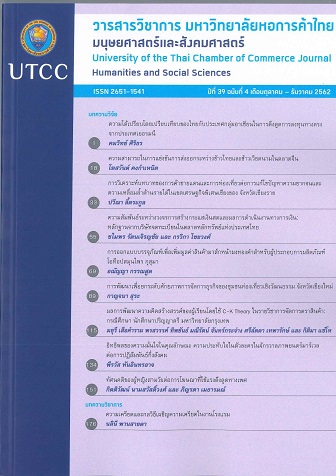The Comparative Advantage of Thailand Compared with ASEAN Countries to Attracting Foreign Direct Investment from Germany
Main Article Content
Abstract
Recently, Germany is now facing a higher labor wage and an appreciation of Euro currency. These would cause its investors to increase their investment in abroad instead. Hence, this research were conducted to study the factors affecting the out flow FDI of Germany in ASEAN countries such as Indonesia, Malaysia, Philippines, Thailand and Vietnam and then compared those factors between Thailand and such countries. Panel data from the World Bank were obtained from 2010 to 2017, totally 8 years. The data were analyzed and found that factors affecting the Germany outflow FDI were the ratio of dependence on aging, number of skilled labor, GDP and net bilateral aid volume from Germany, statistically at 0.05. The comparative advantage analysis of those factors between Thailand and the four ASEAN countries (Indonesia, Malaysia, Philippines, and Vietnam) illustrates that Thailand could gain benefits from a lower dependency ratio than others. GDP was also higher than other countries so this would be an advantage for Thailand. However, the number of skilled labors and net bilateral aid from Germany in Thailand were still less than other countries. Thus, Thailand might lose the FDI to other competitors. As these results, the government should increase the number of skilled labors and level of Thai-German relation in order to attract FDI from Germany to invest in Thailand.
Article Details
ลิขสิทธิ์ของบทความ
ผลงานที่ได้รับการตีพิมพ์ถือเป็นลิขสิทธิ์ของมหาวิทยาลัยหอการค้าไทย ห้ามมิให้นำเนื้อหา ทัศนะ หรือข้อคิดเห็นใด ๆ ของผลงานไปทำซ้ำ ดัดแปลง หรือเผยแพร่ ไม่ว่าทั้งหมดหรือบางส่วนโดยไม่ได้รับอนุญาตเป็นลายลักษณ์อักษรจากมหาวิทยาลัยหอการค้าไทยก่อน
References
ฐาณิญา โอฆะพนม. (2559). ปัจจัยที่มีอิทธิพลต่อการลงทุนโดยตรงจากต่างชาติในประเทศ (วิทยานิพนธ์ปริญญา มหาบัณฑิต ไม่ได้ตีพิมพ์). มหาวิทยาลัยขอนแก่น, ขอนแก่น.
ธนาคารแห่งประเทศไทย. (2560). รายงานภาวะเศรษฐกิจไทย ปี 2559. สืบค้นเมื่อ 1 มิถุนายน 2562, จาก https://www.bot.or.th/Thai/MonetaryPolicy/EconomicConditions/AnnualReport/Pages/default.aspx
ยุทธศักดิ์ คณาสวัสดิ์. (2551, 30 มีนาคม). ความท้าทายของอุตสาหกรรมรถยนต์ของเยอรมนี. ผู้จัดการออนไลน์. สืบค้นจาก https://mgronline.com/daily/detail/9510000037928
อภิรัตน์ จิตต์. (2554). ปัจจัยที่มีอิทธิพลต่อการลงทุนโดยตรงจากต่างประเทศในประเทศไทย (วิทยานิพนธ์ปริญญา มหาบัณฑิต ไม่ได้ตีพิมพ์). มหาวิทยาลัยเกษตรศาสตร์, กรุงเทพฯ.
ASEAN Secretariat. (2018). ASEAN investment report 2018 foreign direct investment and the digital economy in ASEAN. Retrieved June 3, 2019, from https://asean.org/asean-investment-report-2018-published/
ASEAN Statistics Division. (2018). Flows of inward foreign direct investment (FDI) by host country and source country (in million US$). Retrieved June 3, 2019, from https://data.aseanstats.org/fdi-by-hosts-and-sources
Branstetter, L. (2000). Is foreign direct investment a channel of knowledge spillovers? Evidence from Japan's FDI in the United State, NBER Working Paper No. 8015. Cambridge, CA: National Bureau of Economic Research.
Brenton, P., Mauro, F., & Lucke, M. (1999). Economic integration and FDI: An empirical analysis of foreign investment in the EU and in Central and Eastern Europe. Empirica, 26(2), 95–121.
Buckley, P. J., Clegg, J., & Wang, C. (2002). The impact of inward FDI on the performance of Chinese manufacturing firms. Journal of International Business Studies, 33(4), 637–655.
Buthe, T., & Milner, H. V. (2008). The politics of foreign direct investment into developing countries: Increasing FDI through international trade agreements?. American Journal of Political Science, 52(4), 741–762.
Chowdhury, A., & Mavrotas, G. (2003). FDI & growth: What causes what?. Presented at the WIDER Conference on Sharing Global Prosperity, Helsinki, 6-7 September 2003.
Damijan, J. P., Knell, M., Majcen, B., & Rojec, M. (2001). The role of FDI, R&D accumulation and trade in transferring technology to transition countries: evidence from firm panel data for eight transition countries, Working Paper No.10. Ljubljana, Slovenia: Institute for Economic Research.
Girma, S. (2002). Absorptive capacity and productivity spillovers from FDI: a threshold regression analysis. Nottingham, English: The University of Nottingham.
Gunby, P., Jin, Y., & Reed R. W. (2017). Did FDI really cause Chinese economic growth? A meta-analysis. World Development, 90, 242–255.
Hansen, H., & Rand, J. (2005). On the causal links between FDI and growth in developing countries, WIDER Research Paper No. 2005/31. Helsinki, Finland: World Institute for Development Economics Research.
Kolstad, I., & Wiig, A. (2009). What determines Chinese outward FDI?, CMI Working Paper 2009: 3. Bergen, Norway: CMI.
Nair-Reichert, U., & Weinhold, D. (2001). Causality tests for cross-country panels: a new look at FDI and economic growth in developing countries. Oxford Bulletin of Economics and Statistics, 63(2), 153-171.
Nistor, P. (2014). FDI and economic growth, the case of Romania. Procedia Economics and Finance, 15, 577 – 582.
Noorbakhsh, F., Paloni, A., & Youssef, A. (2001). Human capital and FDI inflows to developing countries: New empirical evidence. World Development, 29, 1593-1610.
OICA. (2017). 2017 Production Statistics. Retrieved March 15, 2018, from https://www.oica.net/category/production-statistics/2017-statistics/
Pegkas, P. (2015). The impact of FDI on economic growth in Eurozone countries. The Journal of Economic Asymmetries, 12(2), 124-132.
World Bank. (2017). World Development Indicators. Retrieved March 15, 2018, from https://datacatalog.worldbank.org/dataset/world-development-indicators


